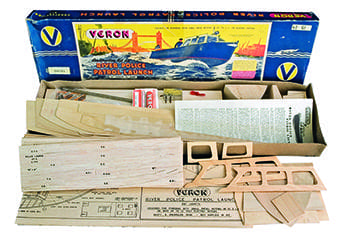
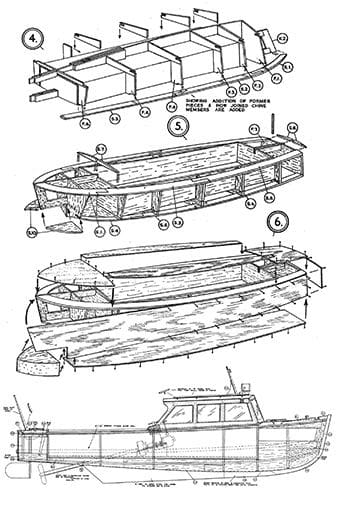
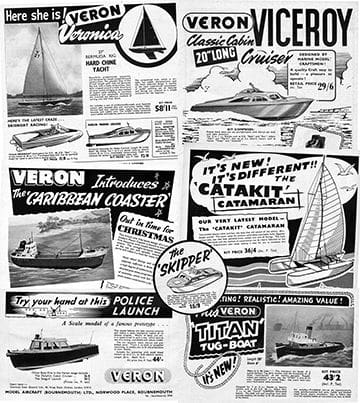
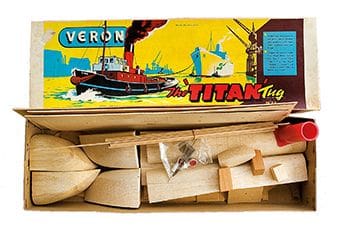
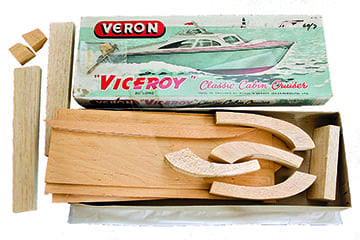
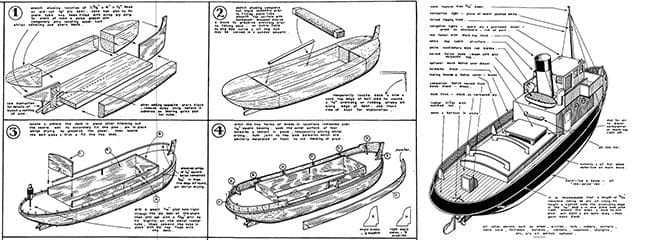
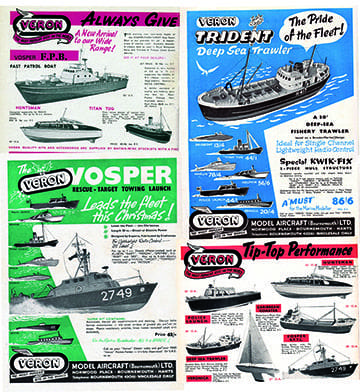
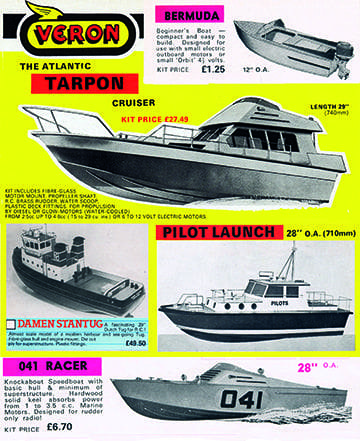
The Veron story is inseparable from that of its chief designer, Phil Smith. Phil was first and foremost an aeromodeller, and his Impala 52 slope-soaring glider design, selling to the tune of 140000 kits, probably introduced more people to the delights of this form of flying than any other, including me. However, it is his model boat kits we are concerned with here, and they too had a firm following among many modellers of the ’50s, ’60s and ’70s, to whom they were the next logical step up from the small Keil Kraft EeZeBilt kits or the like and their first introduction to ‘real’ modelling.
Early days
Veron (the name is derived from Ronald and Vera, the founder and his wife) was the brand name of Model Aircraft (Bournemouth) Ltd. of Pokesdown, Bournemouth, England. In 1946 they employed a young Phil Smith, who had a B.A. degree in Design and Graphics, to design their kits. This involved all aspects of the enterprise, from building the prototype models, testing them, designing the tooling, drafting the plans, writing the instructions, arranging photography and advertising, to designing the box. In his 34 years with the company, Phil was to be responsible for some 300 designs, of which about 20 were for model boats. Through a study of Veron’s advertising over the years it is possible to trace the issue of these.
Enjoy more Model Boats Magazine reading in the monthly magazine.
Click here to subscribe & save.
 |
The May 1952 issue of Model Ships and Power Boats contains the first Veron model boat advertisement I could find, and announces its 26 inch Police Launch at 44s/0d (44 shillings pre-decimal currency, or about £62 today, adjusted for inflation). This was destined to be one of Veron’s most popular boat kits, the clever choice of subject enabling an attractive near-scale model to be built without complicated construction. It was still being recommended in the 1970s as a good follow on model from a basic kit. It is reviewed in that month’s magazine and the writer, not having built a model boat before (one wonders what’s he doing writing for a model boat magazine) finds little to fault apart from the use of balsawood for the detail work such as the rubbing strakes.
I have an example of the Police Launch kit, and as you can see it is mainly of balsawood construction, with plywood hull skinning, deck and superstructure. In this way it differs from the rival Aerokits, which tended not to use balsawood. The result is a light model, with nevertheless most of the outer surfaces being of plywood – an aeromodelling approach perhaps. There are no complaints about the quality of the wood in my kit, and the die-cutting on the printed balsawood sheets is fine. The full-size plan is peppered with Phil’s assembly sketches and is accompanied by a written instruction sheet. They state that no stern tube is supplied, for that would depend on the choice of power plant (up to 2cc diesel or 12v electric), but my kit has the label ‘DIESEL’ stuck to it and came with a heavy duty stern tube and a small fuel tank.
 |
The 1952 advertisement also mentions the 24inch Dolphin Cabin Cruiser at 36s/8d and 18 inch Seagull Launch at 20s/2d. The Seagull, intended for powering by the Electrotor is rarely seen and was discontinued at an early date. A Taycol Target or Asteroid was recommended for the Dolphin when they later became available (May 1956 for the Target & July 1958 for the Asteroid). Skeeter was a small 12 inch speedboat for electric motors that appeared in 1953, the simplest and cheapest Veron kit at 10s/6d.
The 36 inch Marlin cabin cruiser was an important model release for Veron, being the first of its kits that was really large enough to take the bulky radio control gear of the day. It appeared in 1953 at 72s/11d (£94 today) and was reviewed in the November Model Maker who found the design, with its rounded cabin and open front cockpit, the ‘nicest looking power boat yet kitted’. It was for 1cc to 5cc diesel power, or a large electric motor such as the 12V Taycol Supermarine.
Veron kits, like others, used an ‘egg box’ construction method consisting of a rigid compartmented box, to which the formers for the hull were attached. This had the advantage of doing away with the need for a building board, but resulted in some redundant structure. Hull skinning is via single curvature 1/16 inch plywood sheet with balsawood bow blocks, resulting in rather full looking cheeks. A criticism would be the way the main longitudinal members are made up from smaller pieces, requiring careful alignment, and the difficulty of fitting the external keel.
 |
Spindle moulding
The next release was very different, being a 14 inch hydroplane Skid Boat intended for 0.5 to 1cc diesel power, arriving in May 1955 at 11s/8d (£14.30). It was a departure from the norm’ for Veron, as it had a completely pre-shaped balsawood hull into which slotted the twin keels. There were few other components, all of which made for a quick build. This form of construction, using large balsa blocks shaped on a spindle moulder, was to feature in many of Veron’s kits from then on. September 1955 saw the release of the 27 inch Bermuda rigged chined yacht Veronica at 58s/11d (£72) which included a set of sails and pre-formed lead keel.
 |
 |
At the time Veron was sole distributor for nearby Taycol Ltd. motors, and its advertisement featured the Comet and Marine models. The Titan tug came along just in time for the Christmas season in December 1955, priced at 43s/2d (£53). It utilised spindle moulded blocks that resulted in very few parts; a base, two sides, a pair of bow blocks and a pair of stern blocks were joined to a ply keel to complete the basic hull, which measured 20 x 6 inches. Paint alone protected the soft balsawood hull (today we would skin it with fibreglass or nylon) or, following the suggestion in the instructions, a length of 3/32 inch neoprene tubing could be stretched around the hull as a bumper. Die-cut plywood was used for the superstructure and the bag of fittings contained a plastic moulded funnel and ventilators. At least my kit does, as the advertisement curiously mentions a metal funnel, but the box lid keeps its options open by referring to a ready-made funnel. A 0.5 to 0.9cc diesel was recommended for the Titan, or the new Taycol Torpedo electric motor.
No doubt busy designing model aeroplane kits, it wasn’t till December 1957 that we saw Phil’s next effort, the 32 inch Caribbean Coaster. Said to be the first model of a big ship, this used a similar construction to the Titan tug, but with four large blocks forming each of the bow and stern. A price of 98s/-d (£109.50) made it Veron’s most expensive kit at the time, but there was ample space for radio control, with the usual power options. Model Maker’s review in the February 1958 issue showed Phil with Bill Forster, managing director of Veron.
Skipper, a simple 12 inch cabin cruiser using spindle moulded construction, was next, appearing in April 1958 priced at 15s/9d (£17). One casualty of the simple construction was the underside of the hard chine hull, which became flat bottomed with the keel on the centreline forming a T-shape. Cat-a-Kit came next, an extensively pre-fabricated 18 inch catamaran with solid balsa hulls and sails, 36s/4d (£36) in December 1958. The 20 inch Viceroy cabin cruiser was an addition to the line-up in March 1959, at 29s/6d (£31). Like the Skipper, this had a flat bottom with the T-shaped keel and one of the photographs shows the remarkably small number of parts in the kit.
 |
Scale kits
December 1959 brought a return to built-up construction in the form of the 28 inch Vosper RTTL, Veron’s first scale kit, probably inspired by the Model Maker plan of a year previously. This sold for 63s/-d (£63), could be fitted with lightweight radio control, and was intended for up to 1cc diesels or 6V motors. Meanwhile, the Trident deep sea trawler was the offering for December 1960, a 30 inch model with spindle moulded ‘Kwik Fix’ hull. It was based on the Brook-Marine vessel and sold for 86s/6d (£90).
Things then seemed to go quiet for a while until the appearance of the 42 inch Fairey Huntsman kit in 1967. This had a more conventional slotted keel and bulkhead (rather than egg-box) construction and was probably influenced by Model Maker’s plans for this craft, published in February 1962. In fact, the construction is so similar to Vic Smeed’s Model Maker plan that I think it was probably kitted by Veron with a commercial arrangement. It sold for 179s/10d (£150) and was for up to 10cc engines and radio control. December 1968 saw the 52 inch Vosper FPB (Fast Patrol Boat) released; a large kit with a built-up hardwood structure for 3.5cc to 10cc motors (Veron recommended the Webra 61) or large electric motors. This sold for £14.10s.0d (£241) and was a near-scale representation of a class of patrol boat built for the Royal Malaysian Navy, and intended for radio control.
For a relatively short time in 1971 and 1972, the 041 Round Britain Racer joined the line-up, a 28 inch basic speedboat for single channel radio, priced at £6.70p (£93). There was also Bermuda, a small (12 inch) beginner’s boat for electric inboard or outboard motors that sold for only £1.25p, but this only appeared in a few advertisements.
 |
Fibreglass hulls
The final phase of Veron’s kit releases followed the trend of greater pre-fabrication, adopting fibreglass hulls (which were bought-in by Veron) and required just the superstructure to be built by more traditional means. The Tarpon was a 28 inch semi-scale racing cruiser intended for 2.5 to 4.8cc i.c. engines or 6 to 12 volt electric motors. By this time, of course, one could assume the use of radio control, most likely two channel proportional. Similarly, the 28 inch Pilot Launch was for radio control and 1 to 3.5cc engines or 6 to 12 volt motors. These kits came with a stern tube and water-cooling fittings.
The difficult trading conditions that afflicted much of UK industry in the late 1970s caught up with Veron and it was sold to Amerang, primarily balsawood distributors at the time, in 1978. The recent new additions to the range continued to be advertised, along with a selection of the most popular old kits as well as (in 1982) the Damen Stantug, a 29 inch ‘almost scale’ Dutch tug with a fibreglass hull that sold for £49.50p (£170 today). It appears that all was not well within Veron however, and this was virtually the end of the road, with hopes for a renaissance of the kit range fading amidst rumours of large stocks of unsold kits being dumped. Phil Smith retired in 1981, later maintaining an active presence on the internet and selling copies of his designs. He passed away on the 22nd May 2010, aged 93. For once, the achievement of a life dedicated to modelling was recognised by the press and a fitting tribute was posted by The Daily Telegraph in their obituary of 4th June 2010.
It is well worth reading for the greater detail on Phil’s life, and may be found here:




